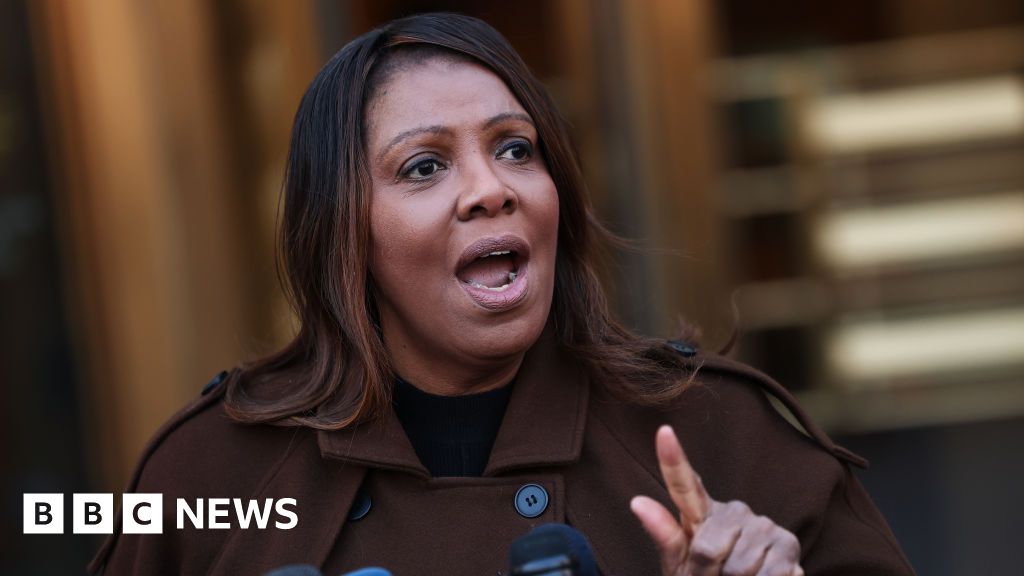New York
More Fish, More Whales, More Ships — and More Whale Strikes

Good morning. We’ll look at what might have been behind the deaths of two more humpback whales off New York and New Jersey. We’ll also see why several hundred convictions are being thrown out in Manhattan.
The Facebook post on the two whale deaths said the cause was “suspected blunt force trauma.”
They were the latest deaths in a troubling year: So far, 23 dead whales have been found from Maine to Florida in 2023, four more than in all of 2022. Twelve of them apparently died off New York and New Jersey, twice as many as in 2022.
The two most recent deaths occurred separately on Thursday. One of the whales, a 47-foot-long male, was buried on the beach at Hampton Bays, on Long Island. The other whale, a 28-foot female, was towed from Raritan Bay to the Gateway National Recreation Area in Sandy Hook, N.J. The post about them, from NOAA Fisheries New England-Mid-Atlantic, a unit of the National Oceanic and Atmospheric Administration, said both had bruises, along with other injuries.
So what happened? Did they collide with ships? Paul Sieswerda, the executive director of Gotham Whale, a whale research and advocacy group in New York, said on Tuesday that it was probably the other way around. “Where and how they are struck is still a question,” he said.
Many humpbacks that wash up are juveniles, like some 93 percent of humpbacks struck by vessels in the New York Bight, according to research by four scientists from Stony Brook University and one from the Atlantic Marine Conservation Society on Long Island. And there is no question that the shipping lanes around New York are busy these days, Sieswerda said, so it is as if “they’re playing in traffic.”
Some marine experts say that online shopping has contributed to higher mortality by putting more whales in the path of more ships carrying products to the ports in New York and New Jersey. And the ships themselves are bigger than they once were. The ports in New Jersey became accessible to the world’s largest cargo ships in 2017, after the Bayonne Bridge was raised, increasing the clearance underneath.
More food, more trouble
The ship strikes seem to be a downside to what Frank Quevedo, the executive director of the South Fork Natural History Museum on Long Island, called a success story. There is more food in the waters off New York these days — specifically, Atlantic menhaden. They are “the most important fish in the ocean” because “everything feeds on them,” Quevedo said.
Whales, dolphins, sharks, ospreys and eagles all love menhaden, he said. So do striped bass. The menhaden population has grown, Quevedo said on Tuesday, because of a four-year-old state law that barred fisherman from using big nets to target schools of menhaden. The nets, some as large as six city blocks, were weighted down at the bottom and could be closed at the top, trapping the fish.
Banning the nets left more menhaden in the water, he said, attracting whales that hunger for them. Sieswerda added: “We used to like to say New York was a place to come to eat for fine food — and the whales felt the same way. But the risk has multiplied, sorry to say. It’s more dangerous for the whales now.”
Or, as Quevedo put it, the whales “are interacting with ships and boats, their larger propellers.”
“Once you get hit by a cargo ship or a commercial dragger,” he said, “it’s just like us, if we get hit by a car.”
Weather
Haze and smoke drifting our way from Canadian wildfires are expected to continue today but will probably vary in intensity. That means that air quality is likely to be near or at unhealthy levels, and it would be worth checking the air quality in your neighborhood before doing anything outdoors for long periods.
Beyond that, prepare for a chance of showers and temps near the mid-70s during the day. This evening will be partly cloudy, with temps dropping to the high 50s.
ALTERNATE-SIDE PARKING
In effect until June 19 (Juneteenth).
The latest New York news
More than 300 cases are thrown out
First a group of the police officers, sergeants and detectives were convicted of crimes related to their work. Now hundreds of the cases they worked on are being thrown out.
The Manhattan district attorney, Alvin Bragg, said in a statement that his office sought the dismissal of more than 300 convictions because of due process violations. The oldest dated to 1996, the most recent to 2017. The vast majority were misdemeanors, and they were thrown out on Tuesday in Manhattan Criminal Court. My colleague Hurubie Meko writes that two more misdemeanors, along with eight felonies, are expected to be tossed today in State Supreme Court in Manhattan.
Bragg, who has highlighted police accountability since taking office last year, said he continued to “prioritize investigating and clearing convictions that undermine trust in the criminal justice system.” Bragg’s office has been reviewing more than 1,100 cases brought by 22 former police officers who have been convicted of crimes.
Eight of the officers who brought the cases vacated on Tuesday have been convicted on charges like official misconduct, planting evidence, taking bribes and lying under oath. A ninth officer, Oscar Sandino, has been convicted of two counts of deprivation of civil rights, a federal misdemeanor, for coerced sexual misconduct against two women in custody.
Advocates have said that one challenge they face is informing everyone who has had a case vacated. Elizabeth Felber, the head of the wrongful conviction unit at the Legal Aid Society, said after a round of dismissals in November that someone at Legal Aid had been assigned to check databases for telephone numbers.
Felber said in a statement on Tuesday that she hoped that “this moment delivers some justice and closure” to the people whose lives were affected by the officers’ actions.
But she added: “The sad reality is that many were forced to suffer incarceration, hefty legal fees, loss of employment, housing instability, severed access to critical benefits and other collateral consequences.”
METROPOLITAN diary
Defying the jackhammer
Dear Diary:
I work in the voice-over industry, which shifted entirely to recording from home during the pandemic. I already had the quintessential New York City home studio: a closet, treated with foam and sound-dampening tiles, where I recorded countless auditions and jobs.
So I was prepared in 2020 when I landed a series of national television commercials that would run for months and into the holidays. It was a big deal.
I savored the news for a moment before the sound of Con Edison working outside reminded me that the gas lines were being replaced. My studio may be pin-drop quiet, but nothing defies the mighty jackhammer.
I whisked myself down to the street in search of a guy with a clipboard.
“Wondering your Monday schedule from 1-2 p.m.?” I shouted when I found him. “I’m a voice-over actor and I booked a commercial and … ”
“Monday, huh?” he shouted back, scanning the clipboard. “We have work planned that’s going to be pretty loud.”
My heart sank.
“But these are crazy times,” he said. “Let me see what I can do.”
When Monday morning arrived, Con Ed was loud at work. At the stroke of 1, though, the street fell totally silent. It stayed that way for an hour.
— Sarah Sweeney

New York
Read the Ruling on the Judgment Against Trump in the E. Jean Carroll Case

Case: 24-644, 09/08/2025, DktEntry: 134.1, Page 28 of 70
statements at issue in this case were made three years earlier than the statement
in Carroll II, the statements were identical in material respects because both
accused Carroll of fabricating the sexual assault allegations for improper
purposes. Compare supra pp. 6-8 (June 2019 statements), with supra pp. 13-14 (October 2022 statement). 14
The truth or falsity of Trump’s statements in both 2019 and 2022
turned on whether Carroll was lying, that is, whether Trump sexually assaulted Carroll in 1996, irrespective of the specific sexual act committed. 15 The jury in
14
–
For example, in the 2022 statement which the Carroll II jury determined to be false — Trump stated, among other things: “I have no idea who [E. Jean Carroll] is.” Carroll, 690 F. Supp. 3d at 401. In the June 21, 2019 statement at issue here, Trump said: “I’ve never met this person in my life.” App’x at 1887. Moreover, in the 2022 statement, Trump said: “She completely made up a story that I met her . . . and, within minutes, ‘swooned’ her. It is a Hoax and a lie,” “it never happened,” and “for the record, E. Jean Carroll is not telling the truth, is a woman who I had nothing to do with, didn’t know, and would have no interest in knowing her if I ever had the chance.” Supp. App’x at 108. In the June 21, 2019 statement, Trump said: “Shame on those who make up false stories of assault to try to get publicity for themselves,” “I would like to thank Bergdorf Goodman for confirming that they have no video footage of any such incident, because it never happened,” and “[f]alse accusations diminish the severity of real assault.” App’x at 1887.
15
In other words, the application of issue preclusion to the falsity element is proper because Trump’s 2019 and 2022 statements did not turn on the specific sexual act he committed. He did not deny, for example, digital penetration specifically. In all statements, he denied any sexual assault, full stop. The Carroll II jury found Trump’s 2022 statement to be false because it found that he sexually abused Carroll. See Tannerite Sports, LLC v. NBCUniversal News Grp., a division of NBCUniversal Media, LLC, 864 F.3d 236, 242 (2d Cir. 2017) (Under New York law, “to satisfy the falsity element of a
28
New York
13 Off Broadway Shows to See in September

‘The Wild Duck’
Henrik Ibsen’s searing dissections of bourgeois hypocrisies appear to be in sync with our angry times. The Norwegian playwright is even getting high-profile movie adaptations, with the Tessa Thompson-starring “Hedda” dropping in October. In New York, Simon Godwin’s production of this semi-obscure effort from 1884, about a family’s secrets coming to light, follows recent revivals of “An Enemy of the People,” “A Doll’s House” and “Ghosts.” (Through Sept. 28, Theater for a New Audience)
‘Mexodus’
In their hip-hop musical, Nygel D. Robinson and Brian Quijada portray an enslaved man and the sharecropper-turned-soldier he meets at the Rio Grande. The story looks at a different kind of Underground Railroad while also connecting to our current turbulence with an era-transcending message of solidarity. David Mendizábal directs the two-man show, which is part of Audible Theater’s series. (Sept. 9-Oct. 11, Minetta Lane Theater)
The Small Rooms Where It Happens
Grier Mathiot and Billy McEntee’s lovely “The Voices in Your Head” was staged for about 20 people at a time in a storefront church last year. McEntee’s “Slanted Floors” goes even smaller: The actors Kyle Beltran and Adam Chanler-Berat portray a couple living out their domesticity under the watch of five audience members in a Brooklyn apartment. (Sept. 9-Oct. 10, Slanted Floors Play).
A collaboration between Hansol Jung (“Wolf Play”) and the collective The Pack, co-directed by Jung and Dustin Wills, “Last Call, a Play with Cocktails” takes place in various New York City apartments, so the audience size varies depending on where the show lands on any given day. One constant: There will be drinks. (Sept. 19-Oct. 13, En Garde Arts)
‘Family’
Alec Duffy’s original staging of “Family,” an early work by the playwright-turned-filmmaker Celine Song, took place in a Brooklyn apartment for audiences of about 30. The production — outré, operatically gothic, near-feral at times — is returning for an encore run, but in a more traditional theatrical space. Let’s see how Duffy recalibrates the show. (Sept. 12-28, La MaMa)
‘The Essentialisn’t’
“Can you be Black and not perform?” Such is the question driving Eisa Davis’s new piece, in which she leads a cast of four. A Pulitzer Prize finalist for her haunting play “Bulrusher” and the co-creator of the concept album “Warriors” with Lin-Manuel Miranda, Davis remains a frustratingly underrecognized writer and performer with a lyrical, fiercely poetic voice all her own. Here is an opportunity to watch her confront and subvert the expectations placed on Black artists. (Sept. 10-28; Here Arts Center)
‘The Other Americans’
John Leguizamo’s stage career is paved with solo shows, sometimes autobiographical, in which he brings to life a gallery of characters. At first glance it looks as if his latest piece might be more of the same since it involves a Colombian American New Yorker, like the writer-performer himself. But while Leguizamo does play that central character, Nelson, he is far from alone onstage: “The Other Americans,” directed by Ruben Santiago-Hudson, is a family drama with an actual cast — it’ll be exciting to watch Leguizamo jostle with costars. (Sept. 11-Oct. 19, Public Theater)
‘Caroline’
Chloë Grace Moretz was only 17 when she starred in Scott Z. Burns’s “The Library” at the Public Theater, in 2014, but her screen career was already buzzing. Still, few expected that it would take over a decade for Moretz to return to the New York stage. At long last here she is again, under the direction of the ever-reliable David Cromer (whose recent credits include “Dead Outlaw” and “Good Night, and Good Luck”). The three characters in Preston Max Allen’s new play are all members of one family, with Moretz in the middle as the daughter of the character played by Amy Landecker (“Transparent”) and the mother of young Caroline (River Lipe-Smith). (Sept. 12-Oct. 19, MCC Theater)
‘Are the Bennet Girls OK?’
After its successful country musical “Music City” last year, the Bedlam company returns to one of its foundational authors: Jane Austen (Kate Hamill’s adaptation of “Sense and Sensibility” was an early Bedlam hit in 2014). Now Emily Breeze’s new take on “Pride and Prejudice” looks like it’s going to have fun with the Regency superstar’s best-seller: “I haven’t reread the source material since I skimmed it in high school,” Breeze claims. (Sept. 14-Oct. 19, West End Theater)
‘When the Hurlyburly’s Done’
After dedicating a decade to his “Rhinebeck Panorama” project, which includes the Apple, Gabriel and Michael family cycles, the writer-director Richard Nelson set out for war-torn Kyiv to work with the local Theater on Podil on a staging of his 2008 play “Conversations in Tusculum.” So inspired was he by the experience that he wrote the company this piece, about Ukrainian actors performing “Macbeth” in 1920. The resulting production (in Ukrainian with English supertitles) settles at Nelson’s frequent artistic home, the Public Theater, for a short run. (Sept. 16-21, Public Theater)
‘Weather Girl’
These days weather reporters like Stacey (Julia McDermott) are called upon to deliver apocalyptic accounts of a world either drowning in floods or bursting into flames along with their forecasts. Written by Brian Watkins (the creator of the time-travel Western series “Outer Range”), this solo play straddles satire and warning. (Sept. 16-Oct. 12, St. Ann’s Warehouse)
‘And Then We Were No More’
The most intriguing pairing this month may well be that of Elizabeth Marvel and Tim Blake Nelson. They are not onstage together, though: Marvel stars in this new play by Nelson, who somehow finds time to write (he also has a novel, “Superhero,” coming out in December) in between gigs as an ur-character actor (next up: the film “Bang Bang” and the series “The Lowdown”). Marvel plays a lawyer in a near-future society where the justice system is even more out of whack than our current one. (Sept. 19-Nov. 2, La MaMa)
‘Torera’
The title character of Monet Hurst-Mendoza’s play is a young Mexican woman, portrayed by Jacqueline Guillén, who yearns to make a space for herself in bullfighting — which the WP Theater’s site noncommittally refers to as “a controversial practice that we neither condemn nor condone.” Tatiana Pandiani choreographs and directs. (Sept. 20-Oct. 19, WP Theater)
‘Crooked Cross’
Sally Carson’s play premiered in Britain in 1935 and takes place just a couple of years earlier, in Germany — you can guess what the title refers to. The show, based on Carson’s own novel, presciently tracks the rise of Nazism through the prism of a divided Bavarian family. (Sept. 20-Nov. 1, Mint Theater)
‘All Right. Good Night.’
N.Y.U. Skirball plays a vital role in the New York cultural ecosystem by programming radical theatermakers from around the world, albeit for blink-and-you’ll-miss-them runs. Such is the case with this piece by the experimental German company Rimini Protokoll (“Remote New York”) in which Helgard Haug intertwines the disappearance of a Malaysia Airlines flight in 2014 with her father’s slide into dementia. Bonus: a live score by the exquisite Berlin-based musician Barbara Morgenstern and Zafraan Ensemble. (Sept. 25-27, N.Y.U. Skirball)
New York
Take a Closer Look at These ‘Great’ New York City Trees

Species Magnolia grandiflora
In 1968, this magnolia tree, then over 40 feet tall, was supposed to be cut down to make way for an apartment complex. Hattie Carthan jumped into action. Ms. Carthan, an environmentalist and activist in the Black community, moved to Brooklyn in 1928 and had a deep love for trees. In 1966, she founded the Bedford-Stuyvesant Beautification Committee, which planted more than 1,500 trees and also taught youth groups about caring for them — not a popular mission at the time. “When I first suggested that we buy trees, I almost got thrown out of the block association,” Ms. Carthan told The New York Times in 1975. “They said, ‘Oh, trees make leaves and you have to sweep.’”
Ms. Carthan was so determined to save the magnolia on Lafayette Avenue, which was estimated to have been planted in about 1885, that she campaigned for it to be designated by the city’s Landmarks Preservation Commission as a living landmark — and won. Today it is the sole remaining landmark tree in New York City.
In 1972, Ms. Carthan created the Magnolia Tree Earth Center, which, despite her death in 1984, continues to educate young people about environmental issues. The center is facing financial hardship, but there is hope that it will be revitalized, said Wayne Devonish, the chairman of its board. “We need to embrace all that it represents in terms of being like a little urban oasis, smack dab in central Brooklyn,” he said. “If we show the tree, and the center, love, hopefully there’s another good 100 — or 200 — years.”
-

 Augusta, GA4 days ago
Augusta, GA4 days ago‘Boom! Blew up right there’: Train slams into semi in Grovetown
-

 Wisconsin5 days ago
Wisconsin5 days agoAppleton Public Library wins 2025 Wisconsin Library of the Year award for distinguished service
-

 Vermont5 days ago
Vermont5 days agoFeds: Springfield dealer ran his drug business from Vermont jail
-
Business5 days ago
Los Angeles Times Media Group takes step to go public
-
Virginia5 days ago
Match 13 Preview: #8 Virginia
-

 West Virginia6 days ago
West Virginia6 days agoWest Virginia eatery among Yelp’s “outrageous outdoor dining spots”
-

 News4 days ago
News4 days agoWhat we know about the charges against New York’s Attorney General Letitia James
-

 Politics5 days ago
Politics5 days agoSpanberger refuses to urge Jay Jones to exit race, dodges questions after ‘two bullets’ texts
















